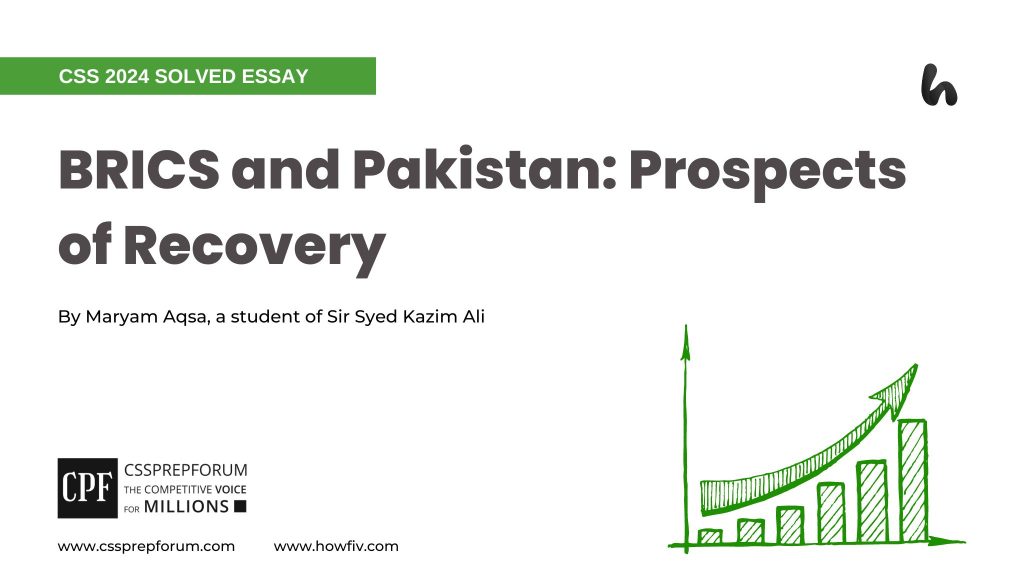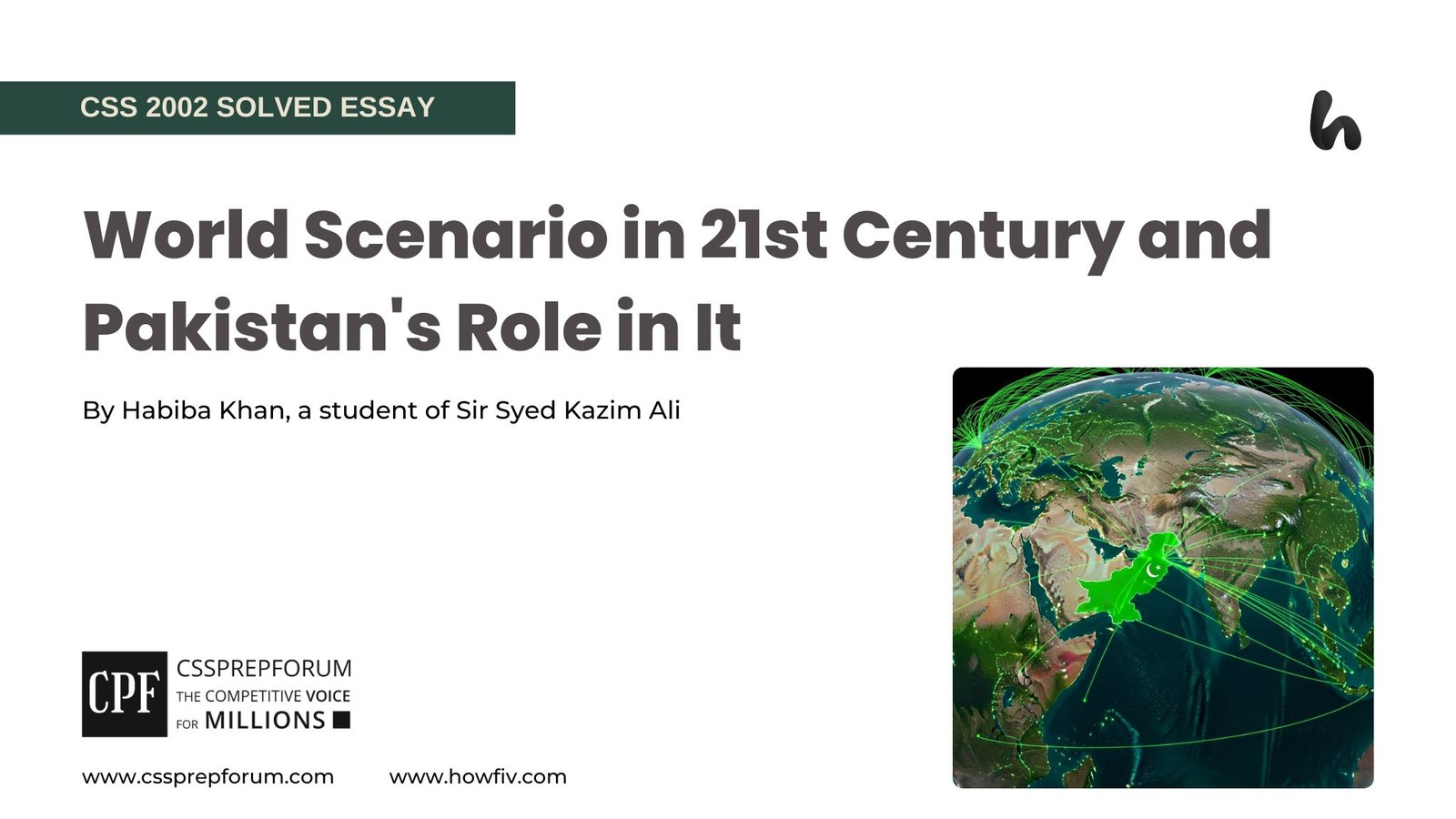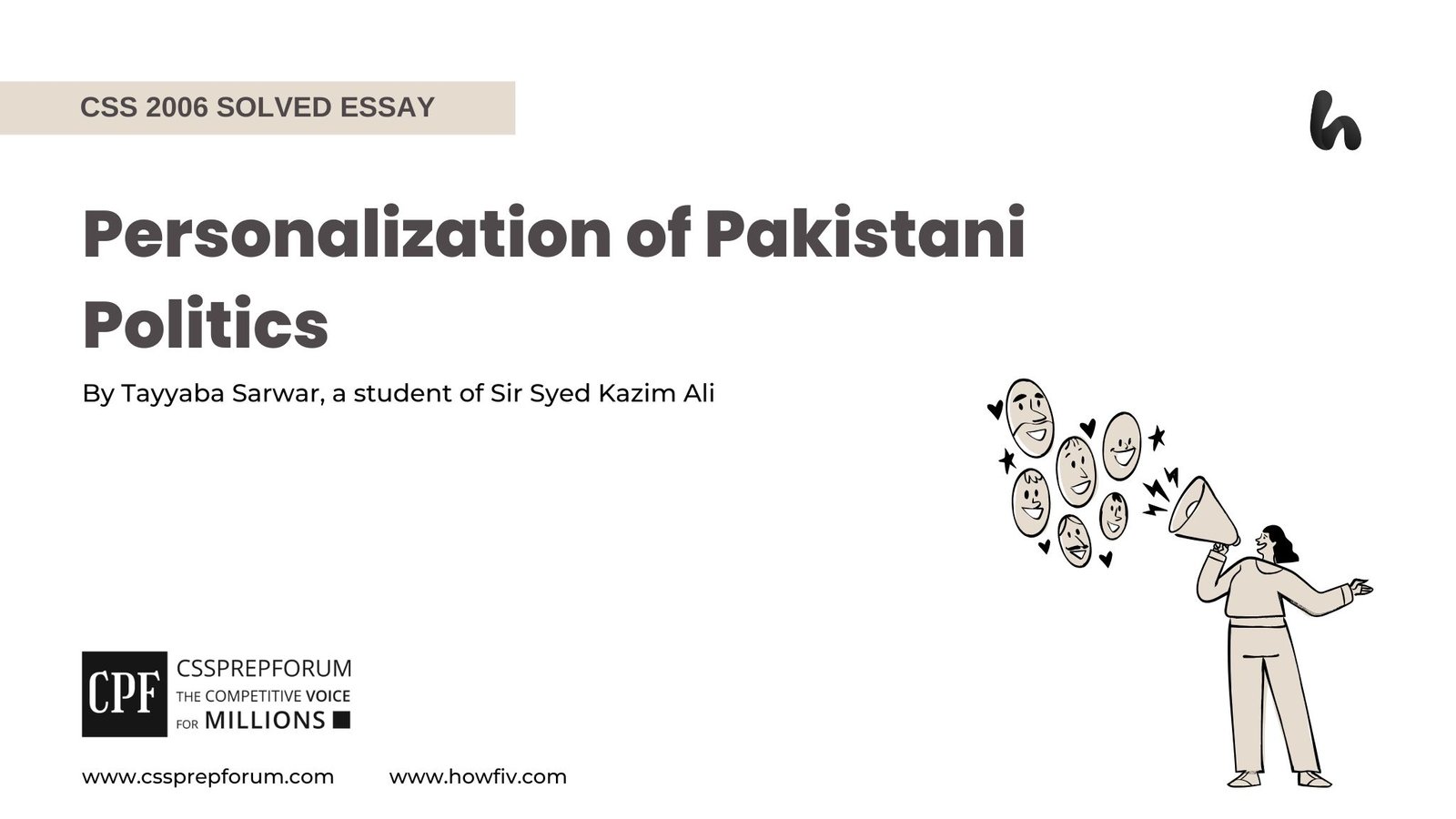CSS 2024 Solved Essay | BRICS and Pakistan: Prospects of Recovery
Maryam Aqsa, a Sir Syed Kazim Ali student, has attempted the CSS 2024 Solved Essay “BRICS and Pakistan: Prospects of Recovery” on the given pattern, which Sir Syed Kazim Ali teaches his students. Sir Syed Kazim Ali has been Pakistan’s top English writing and CSS, PMS essay and precis coach with the highest success rate of his students. The essay is uploaded to help other competitive aspirants learn and practice essay writing techniques and patterns to qualify for the essay paper.

Outline
1-Introduction
Although the huge investment of India in BRICS has always stepped Pakistan away from joining BRICS, still the strong support of China and the demand of BRICS to expand their membership have made way for Pakistan in BRICS, and this inclusion presents Pakistan with a significant opportunity for economic recovery and development, offering access to trade, investment, and resources crucial for overcoming its current challenges.
2-Unwrapping the term BRICS and its objectives
3-Understanding economic significance of BRICS
4-What are the factors that influence BRICS to accept Pakistan as a group member?
- ✓China endeavours to wipeout democracy (China interferes in the Canadian election- a democratic country- and tries to make colonization)
- ✓BRICS need to expand their membership to Bric as a transit currency worldwide (Europe needed countries to accept the Euro as a transit monetary).
5-What prospects of recovery would Pakistan gain after joining BRICS?
- ✓To reduce debt burden
- Evidence: South Korea recover from the Asian financial crisis after joining the economic cooperation and development
- ✓To enhance trade opportunities
- Evidence: ASEAN members like Vietnam have made significant technological strides through regional cooperation and integration, benefiting from shared resources, collaborative projects, and increased foreign investment.
- ✓To increase foreign direct investment
- Evidence: After joining the Eurasian Economic Union (EAEU) in 2015, Kazakhstan experienced an increase in FDI. The union facilitated easier trade and investment between member states, boosting investor confidence.
- ✓To alleviate the US influence
- Evidence: In 2001, the Republic of China has joined the World Trade Organization. Consequently, the country promoted their technology and flourishing economy and mitigated the influence of the USA on the Republic of China
- ✓To facilitate technological advancement
- Evidence: South Korea saw substantial technological development after joining the Organization for Economic Cooperation and Development (OECD)
- ✓To advance the agricultural sector
- Evidence: Rwanda’s membership in the East African Community (EAC) since 2007 has contributed to advancements in its agricultural sector. The country has benefited from regional cooperation, trade, and agricultural investment.
- ✓To establish educational and research partnership
- Evidence: India has improved its education sector through its involvement in BRICS (Brazil, Russia, India, China, and South Africa). BRICS nations collaborate on educational initiatives such as student exchange programs, joint research projects, and educational technology development, which have positively impacted India’s education system.
- ✓To strong geopolitical alliances
- Evidence: Afterthedivision of Germany, the country built relations with EU members and strengthened diplomatic ties
- To promote tourism
- Evidence: After joining the Pacific Alliance in 2011, Mexico saw increased tourism from other member countries (Chile, Colombia, and Peru). The alliance promotes regional cooperation and tourism marketing initiatives, enhancing Mexico’s visibility as a tourist destination.
6-On what grounds do critics believe Pakistan does not benefit from joining BRICS?
- ✓Counter argument: India- a huge investor in BRICS- deny to add Pakistan as a member of BRICS
- Refutation: China counters India and supports Pakistan
- Evidence: China has veto power in the United Nations Security Council, which prevents India’s entry into world trade and health organizations.
- Refutation: China counters India and supports Pakistan
- ✓Counter Argument: Pakistan is considered a terrorist state, thereby relying on BRICS would not be a good option for Pakistan
- Refutation: Pakistan has successfully countered terrorism with the help of international organization.
- Evidence: Pakistan collaborates with the United Nations and regional alliances like SAARC and SCO, improving the country’s regional and international security and counter-terrorism.
- Refutation: Pakistan has successfully countered terrorism with the help of international organization.
7-Critical Analysis
8-Conclusion

In the ever-evolving landscape of global economic alliances, including new member states often flares intense debate and speculation. One such scenario is the potential inclusion of Pakistan into BRICS, an economic bloc currently comprising Brazil, Russia, India, China, and South Africa. Although India’s significant investment in BRICS has historically impeded Pakistan’s membership prospects, the unwavering support of China and BRICS’s strategic intent to expand its membership base have opened new avenues. Indeed, this inclusion presents Pakistan with a significant economic recovery and development opportunity, offering access to trade, investment, and resources crucial for overcoming its current challenges. In fact, by joining BRICS, Pakistan benefits in numerous ways, including debt reduction, enhanced trade opportunities, increased foreign direct investment, and technological advancement. However, critics argue that Pakistan’s controversial reputation and India’s influential position within BRICS could hinder its benefits. Despite these concerns, China’s backing and Pakistan’s recent efforts to counter terrorism could mitigate these challenges. This essay explores the multifaceted dimensions of BRICS, the factors influencing Pakistan’s potential membership, and the prospects of recovery, ultimately arguing for the transformative potential of Pakistan’s inclusion in BRICS.
Before exploring how BRICS can fortify Pakistan’s economy, it is crucial to understand what BRICS is and what its objective is. Unzipping the code, BRICS is a group of five member countries, including Brazil, Russia, India, China, and South Africa, emerging as economic and political powers at the regional and international levels. They cover 30% of the world’s land surface, 45% of the global population, and a GDP of a combined nominal is US$28 trillion (about 27% of the gross world product). Moreover, these countries aim to resolve territorial, political, and economic disputes, promoting equality and mutual benefit in the region. They establish deeper ties among member nations and cooperate in economic expansion, including trade. The countries act as a counterbalance to traditional Western influence and policy. So, it is right that BRICS aims to promote mutual benefit, equality, and economic development in the country.
Analyzing the economic significance of the BRICS alliance, it is composed of Brazil, Russia, India, China, and South Africa and is a significant economic force globally. These nations together account for over 40% of the global population and approximately a quarter of the world’s GDP, making them key players in international trade and investment. Each country brings unique economic strengths, such as China’s manufacturing capabilities, Brazil’s agricultural resources, and Russia’s energy reserves. This diversity creates a solid foundation for mutual growth and global economic influence. Further, the BRICS nations collaborate on various fronts, including trade agreements, financial cooperation through institutions like the New Development Bank, and joint ventures in technology and infrastructure projects. Their combined economic power not only strengthens their position in global economic discussions but also provides a counterbalance to the traditional dominance of Western powers. By promoting trade and investment within the alliance, the BRICS contributes to a more balanced and multipolar global economic landscape.
Besides discussing the understanding and its objective, it is time to examine several factors that can contribute to the triumphant entry of Pakistan into BRICS. Initially, Pakistan’s long and robust relationship with China is its potential inclusion in BRICS. Both countries are trading partners and support each other during difficult times. CPEC is a testament to the strong relationship between China and Pakistan. This is why China supports Pakistan’s inclusion in BRICS, aiming to counterbalance Western influence globally. The Canadian election has shown that Chinese students studying in Canadian universities influence the outcome by participating in the electoral process and voting for their preferred candidates. The incident indicates that China aims to colonize a powerful democratic country- Canada by building infrastructure and interrupting elections. Moreover, the demand of BRICS to convert into BRICS plus for popularizing the new currency- Bric- is similar to that of European countries that need more countries to recognize the Euro and the desire of BRICS to make BRIC a transit monetary, mitigating the power of the dollar. The completion of the 50-year petrodollar deal and the expansion of BRICS countries worldwide indicate the power shift has shifted from west to east. Thus, Pakistan’s solid relationship with China and demand for BRICS increases Pakistan’s prosperity.
Moving towards the prospects of recovery in Pakistan after joining BRICS, the first and foremost one is Pakistan can reduce its debt burden with the help of BRICS. Indeed, BRICS supports developing countries in reducing financial crises, promoting technologies, and increasing Foreign Direct Investment (FDI) in the country. Consequently, countries move towards progress; they become able to compete with other countries. South Korea is the best example of a country that recovered from the Asian financial crisis by joining the economic cooperation and development. The evidence proves that countries freed themselves from the debt web with the organization’s help. In addition, BRICS announced that it would give $5 million to newly joined countries; with the help of this aid, Pakistan could develop infrastructure and update technologies in the country. Hence, Pakistan can mitigate the influence of the debt trap policy to join BRICS.
Second, Pakistan could enhance trade opportunities through BRICS. It is its ability to reduce tariffs by negotiating bilateral and multilateral trade agreements with BRICS countries. Besides, the government can share resources and focus on labour skills, boosting economic stability and development. For example, one of the ASEAN members like Vietnam has made significant technological strides through regional cooperation and integration, benefiting from shared resources, collaborative projects, and increased foreign investment. Hence, Pakistan should learn lessons from past scenarios and focus on trade opportunities for better economic progress in the country.
In the same way, Pakistan may get opportunities to increase Foreign Direct Investment by becoming a member of BRICS. The collaboration between Pakistan and other countries is strong, helping to invest in the country. With trust, foreigners would invest money to build companies in the country; as a result, job opportunities would increase, new technologies would be promoted, the poverty rate would decrease, crime would be wiped out, and the country would flow towards development. For instance, after joining the Eurasian Economic Union (EAEU) in 2015, Kazakhstan experienced an increase in FDI. The union facilitated easier trade and investment between member states, boosting investor’s confidence. Therefore, Pakistan has a golden chance to come out of the crisis with the help of foreign direct investors.
In addition, BRICS aims to alleviate the US power worldwide. After joining BRICS, Pakistan has benefited from its economic factors by building infrastructure and innovating new technologies in the country. Subsequently, Pakistan can free itself from the control of puppet governments and the USA. History corroborates that in 2001, the Republic of China has joined the World Trade Organization; the country promoted their technology, flourished economy, and mitigated the influence of the USA in the Republic of China. This case highlights the sagacious steps taken by China and how the state wiped out the US authority. Therefore, Pakistan’s entry into BRICS can be an excellent chance to break free from the US influence.
Besides, Pakistan can facilitate technological advancement in its country by joining BRICS. It can give the country numerous benefits: enhanced productivity, improved efficiency, and strengthened diplomatic ties. After joining the Organization for Economic Cooperation and Development (OECD), South Korea has also noticed substantial technological development. These advancements promote South Korea’s innovation by enabling the manufacturing of new products and services that meet emerging market demands. Moreover, they improve communication and collaboration through advanced digital tools, connecting people globally and facilitating remote work. Thus, technological progress can also enhance Pakistan’s access to information and education, empowering individuals with knowledge and skills.
Another benefit to Pakistan after joining BRICS is the advancement of the agricultural sector. The country should learn lessons from advanced countries to adopt resources and technologies to grow the maximum yield of crops with minimum resources. The best example of Rwanda’s membership in the East African Community (EAC) since 2007 has contributed to advancements in its agricultural sector. These technological innovations collectively have enhanced Rwanda’s productivity, sustainability, and efficiency in agriculture, and the country has benefited from regional cooperation, trade, and agricultural investment. Therefore, Pakistan can adopt technologies to maximize the yield of crops with minimum resources by collaborating with the advanced countries of BRICS.
Moreover, Pakistan has another opportunity to establish educational and research partnerships with BRICS. Similarly, India has improved its education sector through its involvement in BRICS (Brazil, Russia, India, China, and South Africa). Truly, the BRICS nations collaborate on educational initiatives, such as student exchange programs, joint research projects, and educational technology development, which have positively impacted India’s education system. As a result, India’s education system has improved. According to the global survey 2024, India ranks 33rd with a quality index of 59.1 whereas Pakistan ranks 83rd with a quality index of 34.7. Thus, Pakistan has lucrative prospects to improve its education system through BRICS.
Also Pakistan can strengthen geopolitical alliances to join BRICS; it ensures the country’s security, builds trusting relations with each other, promotes technologies, and boosts trade relations among Pakistan and the different countries. For instance, after the division of Germany, strong relations with the EU members were forged, and diplomatic ties were bolstered. Moreover, the BRICS organization also strengthens the bond of Muslim countries, which significantly enhances economic growth, political influence, and cultural exchange. Therefore, strengthening geopolitical alliances, which is a dire need for Pakistan’s stability, can be easily done by joining BRICS.
Furthermore, promoting tourism in Pakistan is a way to open economic growth by BRICS. Indeed, tourism stimulates economic activity by generating revenue from visitor spending on accommodations, dining, transportation, and local goods and services. For example, after joining the Pacific Alliance in 2011, Mexico saw increased tourism from other member countries: Chile, Colombia, and Peru. The alliance promotes regional cooperation and tourism marketing initiatives, enhancing Mexico’s visibility as a tourist destination. Moreover, Pakistan can make judicious moves like Mexico. They could develop new infrastructure in the country, creating job opportunities, increasing demand in various areas, and providing income opportunities for local vendors. Henceforth, with the help of BRICS, Pakistan can promote tourism to contribute to economic prosperity, cultural enrichment, and sustainable development in destination regions.
Nonetheless, some analysts interpret that India creates hurdles to Pakistan’s entry into BRICS. Owing to this, it has played a significant and influential role within BRICS and has made substantial investments in various BRICS initiatives, demonstrating its commitment to the group’s objectives. It recorded over US$100 billion in intra-BRICS trade in 2022 and has traded with all members. India endeavours to resolve mutual differences and use them to build strong relations with Africa and South America. On the other hand, China is the tiger member of BRICS, giving full support to Pakistan. Furthermore, the Pakistan-China friendship is globally renowned, with the ability to counter India’s claims about Pakistan. Similarly, in the United Nations Security Council, China has veto power that prevents India from entering the World Trade Organization and World Health Organization. Thus, Pakistan should learn the lesson from other countries and seek to benefit from BRICS.
Apart from this, some countries point out that Pakistan is labelled as a terrorist state, whether the government promotes peace globally or not. While Pakistan actively works within international organizations to counter terrorism by collaborating with the United Nations and regional alliances like SAARC and SCO, sharing intelligence with bodies, such as Interpol and FATF, and participating in joint military operations and training exercises. It enforces international sanctions against designated terrorists, aligns its legal frameworks with global standards, and engages in capacity-building programs to enhance its law enforcement and security capabilities. These initiatives improve both regional and international security. Therefore, Pakistan must recover from its terrorist label.
Critically, the BRICS imparts an equal chance for Pakistan to flourish in their economy and strengthen diplomatic ties. They can also make the chances to solve territorial disputes occurring among neighbouring countries. Moreover, they can alleviate the influence of Western countries, which the IMF unwillingly imposes. Aiding BRICS, the puppet government would erase, and countries would get rid of sanctions by the USA. In short, BRICS can open a bright door to Pakistan if the country takes sensible steps to solve their economic and political issues.
To conclude, BRICS, a group of powerful economic countries, aims to reduce the influence of a unipolar world. Pakistan’s acceptance into BRICS countries could provide economic stability and promote technological advancement. Moreover, China’s support for Pakistan and BRICS’ need to expand membership for recognition of their new currency could open promising opportunities for Pakistan and counter efforts by India. This could stabilize Pakistan’s economy, reduce US influence, and strengthen the country’s diplomatic ties. Joining BRICS would offer Pakistan a platform to alleviate its debt burden, enhance trade opportunities, and attract foreign direct investment, all contributing to sustainable economic recovery. Despite potential challenges, the support from China and the strategic benefits of BRICS membership present Pakistan with a transformative opportunity for growth and development. By leveraging these prospects, Pakistan can navigate its current economic challenges and pave the way for a prosperous future.

CSS Solved Past Papers’ Essays
Looking for the last ten years of CSS and PMS Solved Essays and want to know how Sir Kazim’s students write and score the highest marks in the essays’ papers? Then, click on the CSS Solved Essays to start reading them.
CSS Solved Essays
CSS Solved General Science & Ability Past Papers
Want to read the last ten years’ General Science & Ability Solved Past Papers to learn how to attempt them and to score high? Let’s click on the link below to read them all freely. All past papers have been solved by Miss Iqra Ali & Dr Nishat Baloch, Pakistan’s top CSS GSA coach having the highest score of their students.












